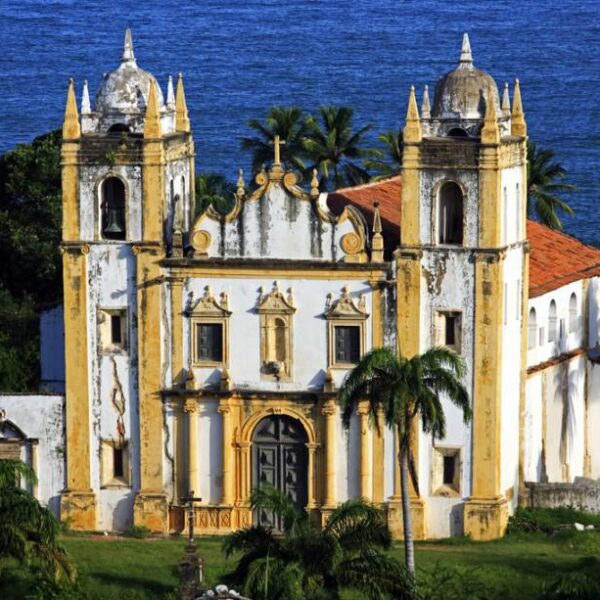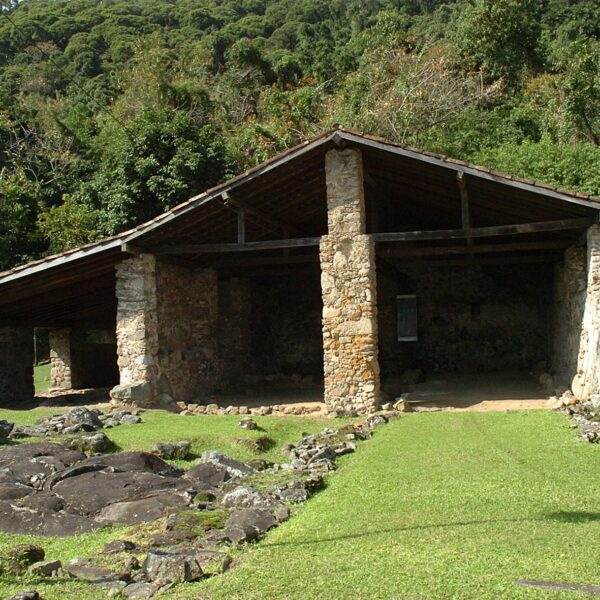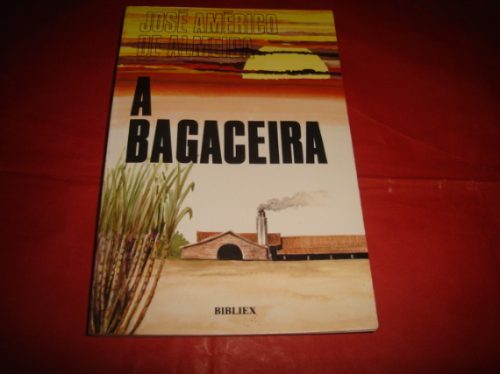According to Simões (1980), the main characteristics that distinguish Portuguese tiles in the first 25 years of the 17th century are monumentality, suitability for architecture and modernity. The Portuguese tile arrived in Brazil in synchrony with the other arts and followed the same process of acculturation existing in Portugal. In […]
Northeastern culture
The Northeastern culture is composed of the states of Alagoas, Bahia, Ceará, Maranhão, Paraíba, Pernambuco, Piauí, Rio Grande do Norte and Sergipe and presents great cultural plurality, such as art, architecture, literature, geography, music and cuisine.
The Northeastern culture is quite diverse, since it was influenced by indigenous, African and European people. Customs and traditions often vary from state to state.
As the first region to be effectively colonised by the Portuguese in the 16th century, who encountered the native populations and were accompanied by Africans brought as slaves, the culture of the Northeast is very particular and typical, although extremely varied. It is based on Luso-Brazilian culture, with major African influences, especially on the coast from Pernambuco to Bahia and in Maranhão, and Amerindian influences, especially in the semi-arid hinterland.
The cultural richness of the northeast region is visible beyond its folkloric and popular manifestations.
Northeastern literature has made a great contribution to the Brazilian literary scene, with names such as João Cabral de Melo Neto, José de Alencar, Jorge Amado, Nelson Rodrigues, Rachel de Queiroz, Gregório de Matos, Clarice Lispector, Graciliano Ramos, Ferreira Gullar and Manuel Bandeira, among many others.
In literature, one can mention the popular literature of cordel, which dates back to the colonial period (cordel literature came with the Portuguese and has its origins in the European Middle Ages) and numerous artistic manifestations of a popular nature that are manifested orally, such as the singers of repentes and embolada.
In classical music, composers Alberto Nepomuceno and Paurillo Barroso stand out, as does Liduíno Pitombeira from Ceará today, and Eleazar de Carvalho as a conductor. Northeastern rhythms and melodies have also inspired composers such as Heitor Villa-Lobos (whose Bachiana brasileira No. 5, for example, in its second part – Dança do Martelo – alludes to the Cariri hinterland).
In popular music in Northeastern culture, rhythms such as coco, xaxado, hammer agalopado, samba de roda, baião, xote, forró, Axé and frevo stand out, among other rhythms. The Armorial movement in Recife, inspired by Ariano Suassuna, did a scholarly job of valorising this popular rhythmic heritage of the Northeast (one of its best-known exponents is the singer Antônio Nóbrega).
In the dance of Northeastern culture, the maracatu, practised in various parts of the Northeast, the frevo (characteristic of Pernambuco), the bumba-meu-boi, the xaxado, various variants of the forró, the tambor-de-crioula (characteristic of Maranhão), etc. stand out. Folk songs are almost always accompanied by dances.
Handicrafts are also an important part of the culture of the Northeast and are the livelihood of thousands of people throughout the region. Due to the regional variety of handicraft traditions, it is difficult to characterise all of them, but the following stand out: woven hammocks and sometimes embroidered with many details; products made of clay, wood (for example, from the carnauba tree typical of the sertão) and leather, with very particular traits; and lace, which has gained prominence in Ceará handicrafts. Another highlight is the bottles with images made by hand in coloured sand, an item produced for sale to tourists. In Maranhão, handicrafts made from buriti fibre (palm tree) stand out, as well as handicrafts and products from babaçu (palm tree native to Maranhão).
Maranhão handicrafts have more than 400 years of tradition
The handicrafts of Maranhão have more than 400 years of tradition, just a visit to the Historic Centre of São Luís and you can see the variety of artefacts from the artisanal production of Maranhão, marked by the creativity of a popular tradition that has been improved since the foundation […]
Influence of Arabic architecture on Pernambuco buildings
Arabic architecture developed in Portugal during the Muslim presence in the country (712-1249). The originality of architectural structures and ornamental motifs gave rise to a very distinctive Muslim architecture. The horseshoe arch, of Visigothic influence, is the hallmark of Muslim civilisation in Portugal. Ornamentation is one of the great characteristics […]
11 historic cities in northeastern Brazil that you need to visit
Get to know the main historical cities of the north-east of Brazil built during the colonial period that still retain a large part of their preserved houses. The history of Brazil is rich, comprehensive and full of contradictions. Developing a narrative that addresses the details of the conquest and colonisation […]
The most beautiful beaches on the coast of Maranhão
The coast of Maranhão has incredible dunes of the Lençóis Maranhenses National Park and mangroves, the beaches of the state of Maranhão have a unique look in the Northeast. On this stretch of the Brazilian coast you can find almost deserted beaches in fishing villages or even in the metropolitan […]
Pedra Caída Complex in Chapada das Mesas
The Pedra Caída Complex in Chapada das Mesas in the state of Maranhão is a must-see attraction for those passing through Chapada das Mesas (MA) and the tip goes even for the less adept at nature activities. The Sanctuary of Pedra Caída in Chapada das Mesas is a large tourist […]
Chapada das Mesas National Park – Tourism Guide
The Chapada das Mesas National Park has sandstone geographic formations, about 70 million years old and that can reach around 400 metres high and is extremely exuberant with its mountains, waterfalls, rivers and lakes that jump to our eyes and provide an incredible experience. The Chapada das Mesas is one […]
Tracunhaém is the “Capital of Ceramic Crafts”
The main attraction of Tracunhaém is the transformation of clay into utilitarian and decorative pieces, thus being the main source of income and employment in the region. The city of Tracunhaém is located 55 km from Recife. The municipality has a name of indigenous origin, meaning “pot of ants”, and […]
Tutóia is the exit to the Lençóis Maranhenses and the Parnaíba River Delta.
The municipality of Tutóia in Maranhão is a support base for those who visit the Lençóis Maranhenses National Park and the Parnaiba River Delta. Tutóia is geographically privileged for being located in front of the Parnaíba River Delta and next to the Little Lençóis Maranhenses. The dunes are one of […]
Macapá Waterfall in the southern region of Maranhão
Macapá Waterfall or Cachoeira do Macapá, located between Balsas and Nova Colinas, South region of Maranhão, with more than 80 meters of waterfall is considered the largest waterfall in the region. The Chapada das Mesas in the southern region of Maranhão exudes beautiful landscapes, enriched by waterfalls and ecological trails. […]
The environmental wealth, geography, flora and fauna of Maranhão
Maranhão is the synthesis state of Brazil. Here characteristics of the North, Northeast and Midwest converge. Different nuances of climate, vegetation, hydrography, coastline, relief, history and culture blend together amid a tropical panel of colors, flavors, sounds, textures, smells and stunning landscapes that portray the Brazilian joy of being from […]
Tropical flowers are grown on a large scale in northeastern Brazil
Tropical flowers of exuberant beauty will adorn many parties this holiday season. Flower cultivation plays a key role in preserving varieties. Much of the beauty of Christmas parties in the southeast of the country depends on tropical flowers grown on a large scale in the Northeast. Pernambuco is the state that […]
Casa Grande & Senzala was the work that consecrated writer Gilberto Freyre
Casa Grande & Senzala was the work that consecrated the Brazilian sociologist and writer Gilberto Freyre. This essay, released on December 1, 1933, addresses the formation and economic-social development of the Northeast during the colonial era. The author sees in the cultivation of sugar cane, in the middle of the […]
Engenho São Jorge dos Erasmos was built in the newly founded town of São Vicente
The São Jorge dos Erasmos Mill was the third sugar mill to be built in Portuguese America, in the center of the village of São Vicente, today in the São Paulo municipality of Santos. It was probably built around 1534 by order of Martim Afonso de Sousa, the donee of […]
History of the emergence of the sugar mill in colonial Brazil
From 1500 to 1822, from discovery to independence, Brazil exported goods worth a total of £586 million. In this total of values, to which production does the largest contingent belong? Gold, one might answer. No: gold contributed only 170 million. Coffee only started at the end, and in our balance […]
José Américo de Almeida left Paraíba to revolutionize northeastern literature
José Américo de Almeida (1887-1980) was a Brazilian writer and politician. His work “A Bagaceira”, started the Regionalist Generation of the Northeast. He was elected to the Brazilian Academy of Letters on October 27, 1966, occupying chair number 38. He was also a lawyer, university professor, folklorist and sociologist. José […]



































